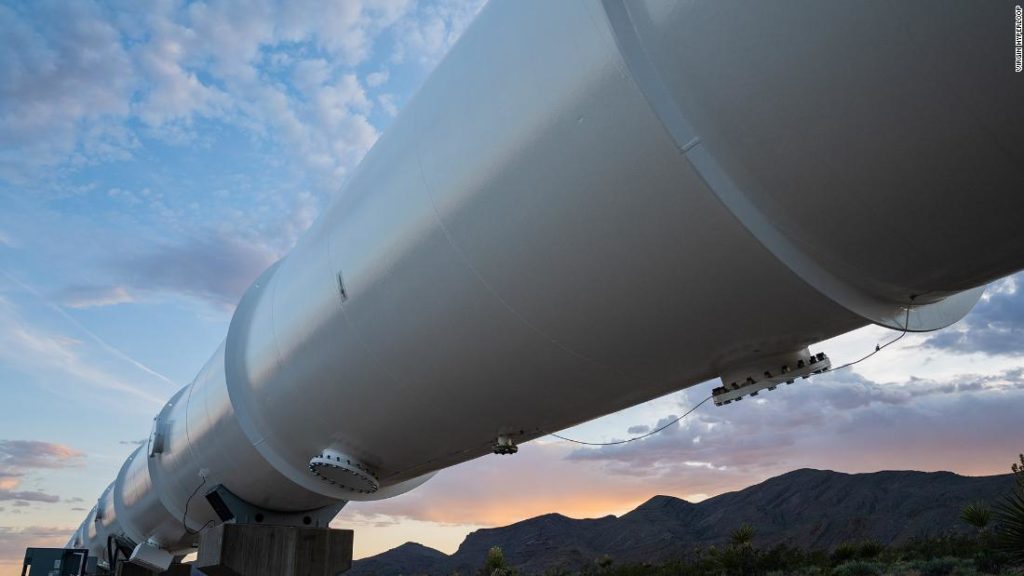Like many of Musk’s endeavors, including electric cars and rockets, it didn’t involve inventing everything from scratch. Musk took existing ideas, re-packaged and rethought them, in hopes of carrying humanity towards a brighter future. But critics aren’t yet entirely convinced the new hyperloop thinking can solve old issues.
“Hyperloop is novel and interesting, and at the same time a very old idea,” Molly Wright Steenson, a Carnegie Mellon University professor who studies technology, communications and design, told CNN Business. “We still face a lot of the problems we faced in 19th century. We’re trying to get people very quickly across time and space, and we still have to contend with traffic.”
Pneumatic tubes were popularized in the 1800s, scholars say, as an alternative to ground transportation. Capsules containing letters were pushed and sucked through tubes at speeds of about 20 or 30 mph, generally in tunnels under big cities. Telegraphs were much faster than pneumatic tubes, but the final steps of their deliveries were inefficient and expensive, as telegraphs needed to be hand delivered from telegraph offices to their final destinations. So pneumatic tubes were often used between telegraph offices and key destinations such as stock exchanges, the scholars say.
The Paris pneumatic tube system peaked in 1945, with 450 kilometers of tubes and 12 million objects being moved that year, Steenson said. The system shut down in 1984 amid stiff competition from the telephone and fax, she said. US cities generally gave up on pneumatic tubes decades earlier, as the truck emerged for delivery in the early 20th century.
Pneumatic tubes generally weren’t built outside big cities, or to individual homes, because the cost of doing so wasn’t practical, according to Holly Kruse, a Rogers State University professor who has researched pneumatic tubes.
The hyperloop emerges
For all the excitement, hyperloops remain an unproven technology that attempts to modernize the idea of marrying trains to pneumatic tubes, and that idea was abandoned long ago for rail travel due to its limitations, among them speed and cost.
Roger Goodall, a Loughborough University professor who studies rail, told CNN Business that’s he’s been surprised at recent investments in hyperloops given drawbacks he sees, including its cost and its ridership capacity.
“Hyperloop seems to be a step too far,” Goodall said.
Contrary to Musk’s projections, Goodall views Hyperloop as a more expensive version of magnetic levitation trains, which he said already struggle to prove that they’re as affordable as traditional high-speed rail trains. On top of the costs of magnetic levitation, hyperloop companies will also have to pay for an enclosed tube that’s keep at low pressure, even though at least one company, Virgin Hyperloop, maintains that operating costs can be kept low.
Hyperloop tracks will also have to be of higher quality than traditional high-speed rail or magnetic levitation, Goodall said, to ensure a smooth ride quality. The faster a train goes the higher quality the tracks needs to be, to ensure imperfections don’t lead to a train that shakes, which could make it difficult to work or read on a train.
Virgin Hyperloop declined to comment on how its overall costs of construction and operation compared to traditional high-speed rail and maglev projects, but said it offered cost savings in certain situations, such as tunneling under a busy street and making tight turns. The company said its tunnels are about half the surface area of high-speed rail tunnels, reducing costs. Virgin Hyperloop also expects cost savings as it can meet real-time demand rather than rely on traditional timetables. The company said it won’t pay to transport empty seats, as can happen with trains.
And Virgin Hyperloop says that the company will see significant cost savings over traditional rail systems when it comes to building in hilly areas.
Virgin Hyperloop will be capable of climbing 10% grades at speeds of 224 mph, which co-founder Josh Giegel described in an email as a more than 6x improvement over high-speed rail.
“A train would be forced to go around the obstacle, adding kilometers of track to the alignment. Hyperloop could simply go straight over, saving substantial material costs,” Giegel said.
Another challenge Goodall sees is how few people Hyperloops will carry. Hyperloops have been described as having smaller train cars than existing trains. With fewer people on board, Goodall said, it could be more challenging to sell enough tickets to cover a system’s costs.
But Virgin Hyperloop told CNN Business that its system will carry more passengers per hour per direction than trains because it will bunch its smaller pods into convoys that are separated from each other by microseconds.
Rail projects tend to be done in by financial troubles and a failure to obtain right of way, however, Goodall said. Hyperloops won’t be immune from these issues, he said, but they may have an easier time getting funding from politicians, who are drawn to new and exciting technologies.
Regulators appear more welcoming today. This summer Elaine Chao, secretary of the Department of Transportation, announced an emerging technology council to make sure that the department didn’t impede the deployment of new technologies such as Hyperloop.
“We welcome the visionaries, the doers, the stakeholders with solutions to today’s transportation problems,” Chao said.
You may also like
-
Afghanistan: Civilian casualties hit record high amid US withdrawal, UN says
-
How Taiwan is trying to defend against a cyber ‘World War III’
-
Pandemic travel news this week: Quarantine escapes and airplane disguises
-
Why would anyone trust Brexit Britain again?
-
Black fungus: A second crisis is killing survivors of India’s worst Covid wave

